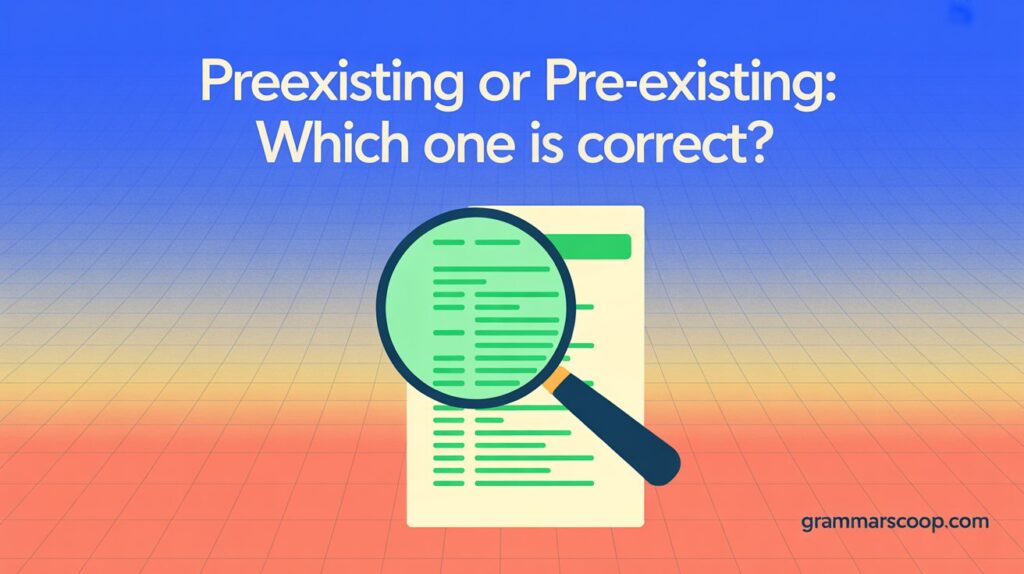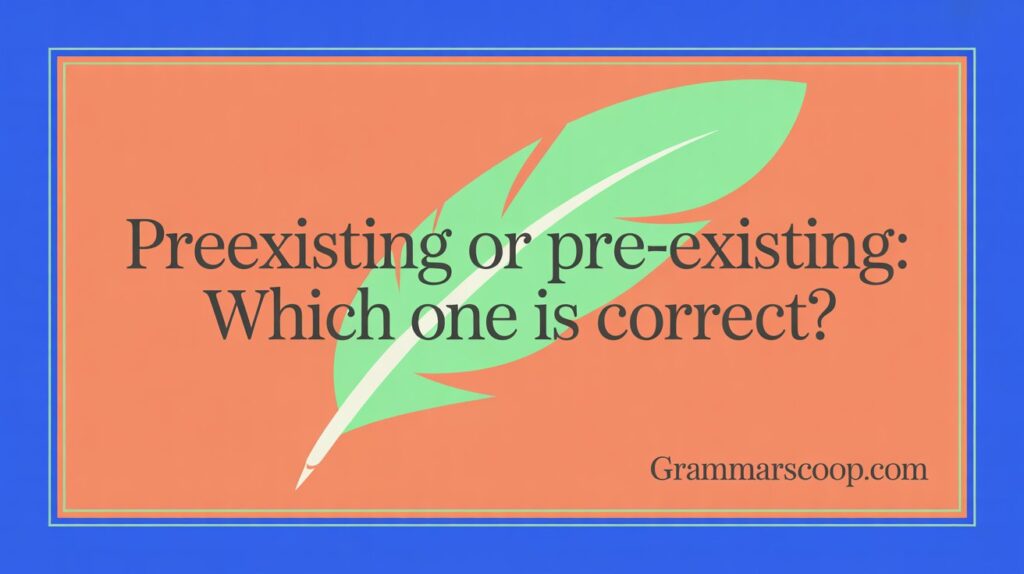Language evolves, and sometimes that means tiny details like a single hyphen spark big debates. One common question many writers, editors, and even professionals in healthcare and law grapple with is this: Should you write preexisting or pre-existing?
The difference might seem minor, but the implications stretch across industries, documents, and clarity in communication. Let’s dive deep into this hyphenation debate and explore which version is correct, why it matters, and how to decide which form to use in your writing.
Quick Summary
Wondering whether to write “preexisting” or “pre-existing”? Both are technically correct, but usage depends on style guides, context, and clarity. The hyphenated form—pre-existing—is often used in formal, legal, and medical writing. Meanwhile, preexisting (without the hyphen) is increasingly common in modern, digital, and informal texts. Major style guides like AP prefer pre-existing, while dictionaries like Merriam-Webster accept both. The key is consistency and audience awareness. This guide breaks down definitions, real-world examples, usage tips, and synonyms to help you choose the right form every time.

The Core Question: Is It “Preexisting” or “Pre-Existing”?
You’ll see both forms used in professional and casual writing. But are they interchangeable?
- Preexisting (no hyphen) is more common in modern writing, especially in digital formats.
- Pre-existing (with a hyphen) is often used in formal documents, especially in legal or medical fields.
The choice depends heavily on context, consistency, and style guide preferences. But both forms are considered correct by major dictionaries—they simply represent different stylistic choices.
What Does “Preexisting” Mean Anyway?
Preexisting Definition
The term “preexisting” or “pre-existing” is an adjective that refers to something that already existed before a certain time, event, or action. It generally implies prior existence or presence.
Pre Existing Meaning in Common Use
- In Insurance: A health condition that existed before a person’s health benefits started.
- In Law: A situation, contract, or relationship that existed before a change in legal status.
- In Tech: A system or software that was already in place before an upgrade or new installation.
“The patient’s preexisting condition was not covered by the new insurance policy.”
Why the Confusion Exists
The uncertainty over preexisting or pre-existing stems from how compound words evolve in the English language. Let’s explore the key factors.
1. Compound Word Evolution
Many compound modifiers start out as hyphenated terms. Over time, as they become more familiar, the hyphen often disappears.
Examples:
| Older (Hyphenated) | Modern (Single Word) |
|---|---|
| on-line | online |
| web-site | website |
| pre-existing | preexisting |
2. Style Guide Variations
Not all style guides agree on the rules for compound modifiers. Some advocate for clarity over tradition.
3. Digital Influence
Search engines and content management systems often favor non-hyphenated terms. “Preexisting” is easier to search and index.
Usage According to Top Style Guides
Let’s look at how authoritative style guides treat the word:
Associated Press (AP) Style
- Prefers hyphens in compound adjectives before a noun: “pre-existing condition”
- Example: “Coverage does not apply to pre-existing conditions.”
Chicago Manual of Style (CMS)
- Recommends consistency throughout a piece.
- Tends to allow closed compounds (no hyphen) when the meaning is clear.
Merriam-Webster Dictionary
- Lists “preexisting” as the primary spelling.
- Hyphenated version appears as a variant.
Oxford English Dictionary (OED)
- Accepts both forms, with a slight preference toward “pre-existing.”
Quote from Merriam-Webster:
“Preexisting: existing at an earlier time; especially: existing before a particular point in time or event.”
Which Should You Use? Key Decision Factors
Consistency Matters Most
Once you choose one form, stick with it throughout the document. Inconsistent usage reduces readability and professionalism.
Explore further:
- High-Quality Or High Quality: Which One Is Correct?
- Plural of Journey: Is It Journeys or Journies?
- Liter or Litre: Spelling Differences and When to Use Each
- Agreeance vs Agreement: Which One to Use?
- What’s the Plural of Iris? Explanation with Examples
Readability and Tone
- Use “preexisting” in less formal, modern writing where simplicity is valued.
- Choose “pre-existing” when clarity might be compromised or when writing for traditional audiences.

Audience and Context
| Audience | Recommended Form |
|---|---|
| Medical professionals | Pre-existing |
| Academic readers | Pre-existing |
| Blog or casual readers | Preexisting |
| Legal documents | Pre-existing |
| Tech documentation | Preexisting |
Origin and Evolution of the Term
The word “pre-existing” dates back to early 18th century English, where hyphenation was the norm for compound adjectives. But as compound words became more commonly used, especially in digital and tech writing, the hyphen began disappearing.
Timeline:
- 1700s: Hyphenated use in medical/legal documents
- 1950s-80s: Continued dominance of “pre-existing”
- 2000s-Present: Shift toward “preexisting” in tech and online platforms
Real-World Examples in Sentences
Pre-Existing in Use
- “The pre-existing condition clause disqualified many applicants.”
- “He was unaware of the pre-existing lease agreement.”
Preexisting in Use
- “The software was integrated into the preexisting infrastructure.”
- “Her symptoms were related to a preexisting autoimmune disorder.”
Comparison Table:
| Usage Context | Preferred Form | Sentence Example |
|---|---|---|
| Health Insurance | Pre-existing | “Coverage excludes pre-existing conditions.” |
| IT Infrastructure | Preexisting | “Works with preexisting systems.” |
| Legal Contracts | Pre-existing | “Subject to pre-existing laws.” |
| Informal Blogs | Preexisting | “Based on preexisting knowledge.” |
Synonyms & Related Terms
Sometimes, the best way to avoid the hyphen debate is to rephrase. Let’s explore some strong pre-existing synonym options.
| Synonym/Related Phrase | Meaning | Best Use Case |
|---|---|---|
| Existing prior | Something already in place | Technical writing |
| Already present | Present beforehand | Casual writing |
| Prior condition | Previously diagnosed or known condition | Healthcare |
| Previous | Earlier occurrence or state | General writing |
| Established | Confirmed and accepted as existing | Business/legal documents |
Pro Tip: If clarity is more important than style, a synonym like “prior condition” often works better.
SEO Implications: Which Version Ranks Better?
Digital writers must consider how search engines interpret both spellings.
Google Search Trends
According to Google Trends, “preexisting” generally has a higher search volume, especially in the US, likely due to its prevalence in health and tech content.
Search Volume Comparison:
| Keyword | Monthly Global Searches |
|---|---|
| preexisting | 18,000+ |
| pre-existing | 9,000+ |
| pre-existing synonym | 1,300+ |
| preexisting definition | 1,600+ |
| pre existing meaning | 900+ |
Content Strategy Tip:
Use both spellings strategically within a post to capture diverse search queries, but do it naturally to avoid keyword stuffing penalties.
Final Verdict: Which One Should You Use?
Both “preexisting” and “pre-existing” are correct, but your choice should depend on:
- The style guide you follow
- The audience you’re writing for
- The formality of your content
- The platform or industry standard
Use “preexisting” if:
- You’re writing online, for general readers
- You want modern, SEO-friendly spelling
- You’re aiming for quick readability
Use “pre-existing” if:
- Your content is formal, academic, legal, or medical
- You’re following AP or CMS style strictly
- You need maximum clarity in dense or technical text
Quick Reference Table
| Criteria | Pre-Existing | Preexisting |
|---|---|---|
| AP Style | Yes | No |
| CMS | Yes | Yes (if consistent) |
| Medical Usage | Common | Common |
| Formal Publications | Preferred | Less formal |
| Casual/Modern Writing | Less used | Preferred |
| SEO/Online | Lower ranking | Higher ranking |
Conclusion
This isn’t just a battle of hyphens. It’s a reflection of how English continues to shift with usage, technology, and time. So whether you’re writing a legal brief, health insurance form, or a blog post, knowing when to use preexisting vs. pre-existing gives your writing both accuracy and polish.
Choose wisely, stay consistent, and write with clarity.

Lisa Morris is a seasoned blogger and language enthusiast with a passion for making grammar simple and engaging. At Grammar Scoop, she shares clear, concise tips that help readers master the rules of English with confidence.






